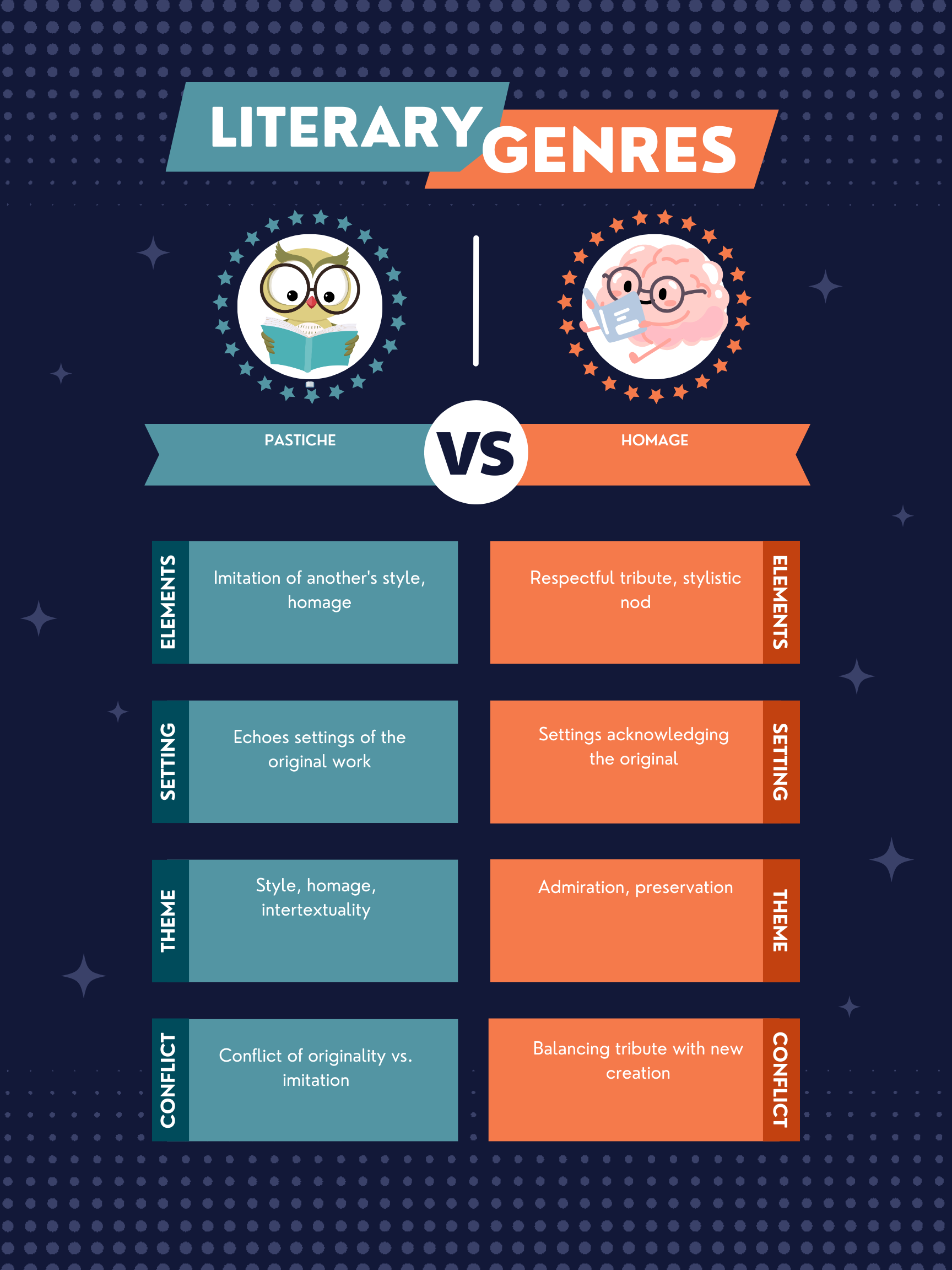Pastiche is a work of literature, film, or music that imitates the style of previous works, often with a mix of parody and respect; Homage shows deep admiration for another work or artist, without the parody aspect of pastiche.
Both pastiche and homage are ways artists and writers connect with and honor the legacy of their predecessors. Let’s delve into these nuanced expressions of reverence. 🎨📖
Pastiche
Pastiche combines or imitates the style of one or more artists or styles. It’s not merely imitation but a celebration or critique, sometimes used to comment on the original work or style it emulates. Quentin Tarantino’s “Kill Bill” series is often cited as a pastiche of martial arts films, spaghetti westerns, and Japanese samurai cinema.
Homage
Homage is a respectful acknowledgment and tribute to another’s work or style, often incorporating elements of the honored work into one’s own, but without imitation as the primary goal. Steven Spielberg’s “Super 8” pays homage to the style and themes of early Spielberg films and the works of producer J.J. Abrams’ influences, like those of producer and director Steven Spielberg.
Summary
| Literary Device | Definition | Purpose | Usage | Relevant Examples |
|---|---|---|---|---|
| Pastiche | A work that imitates the style of previous works, mixing parody and respect. | To celebrate or critique the original works while showcasing creativity. | Literature, film, music. | “Kill Bill” series by Quentin Tarantino. |
| Homage | Shows deep admiration for another work or artist, without parody. | To pay respect and acknowledge the influence of the original works. | Literature, film, music, visual arts. | “Super 8” by J.J. Abrams. |
Writing Tips
For Pastiche:
- Study the Originals: Understand the styles and themes of the works you’re emulating to effectively capture their essence.
- Blend Creatively: Mix elements from various sources to create something unique that still honors the originals.
- Balance Tone: Maintain a respectful tone, even if incorporating elements of parody or critique.
For Homage:
- Identify Key Elements: Focus on what specifically you admire about the original work and wish to honor.
- Incorporate Subtly: Use elements from the original in a way that complements your work without overshadowing your creative voice.
- Maintain Originality: Ensure your work stands on its own merit while paying tribute to its influences.
FAQs
Can a work be both a pastiche and homage?
While they have distinct intentions, a work can have elements of both, creatively imitating while also deeply respecting the source material.
How do I decide to use pastiche or homage in my work?
Consider your intention: if you aim to creatively play with styles or genres while commenting on them, pastiche might be your path. For a more straightforward tribute that acknowledges the influence of previous works, homage is suitable.
Exercise
Read the following excerpt: “The novel’s detective, with his peculiar hat and magnifying glass, solved mysteries in the fog-laden streets of London, his demeanor a clear nod to the great detective Holmes.”
Answer: This passage suggests an homage, specifically acknowledging the influence of Sherlock Holmes without parodying Arthur Conan Doyle’s style.
Other Interesting Literary Device Comparisons
- Allusion vs Intertextuality: Allusion is a brief and indirect reference to a person, place, thing, or idea of historical, cultural, literary, or political significance. In contrast, intertextuality involves the relationship between texts and how they reflect, influence, or relate to each other.
- Satire vs Parody: Satire uses humor, irony, exaggeration, or ridicule to expose and criticize people’s stupidity or vices, particularly in the context of contemporary politics and other topical issues. Parody, on the other hand, mimics the style of a particular genre, work, or artist, often for comic effect.
- Allegory vs Symbolism: Allegory is a narrative in which characters and events represent abstract ideas or moral qualities, often conveying a more complex message. Symbolism uses symbols, be they objects, characters, or colors, to represent deeper, often more abstract concepts or ideas.

